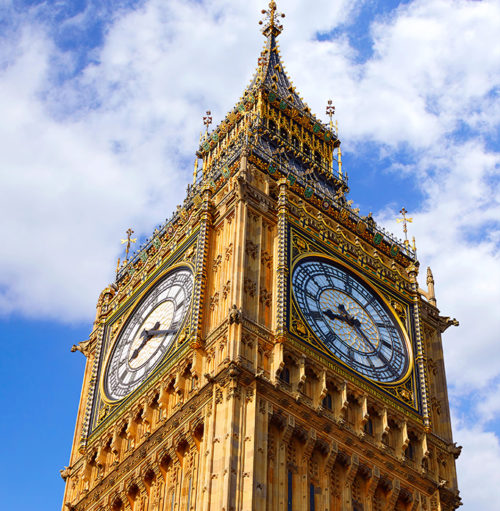It is a symbol of London the world over, but do you know the origins of Big Ben? If you’ve ever asked yourself, ‘when was Big Ben built?’ then read on for a potted history of our most famous landmark
Big Ben has been telling the time for Londoners since the mid 19th century and is now undergoing essential maintenance that has meant Big Ben’s bongs have fallen silent. Works include repairing the clock, as well as the fabric of the tower, and while the whole project is expected to take four years, the bongs will still sound as special events. So as work gets underway to restore the much-loved landmark, we thought it was time to ask: when was Big Ben built?
The origins of London’s Big Ben
Big Ben – the name given to the great bell rather than the actual clock – was installed in the Palace of Westminster clock tower in 1859. Since then it has become Britain’s most famous bell.
Its iconic chimes were first recorded by the BBC on New Year’s Eve in 1923 and are now recorded live by the BBC twice a day, every day, at 6pm and midnight.
And the clock itself, with its four, huge cast iron dials is equally famous. Dominating the Westminster skyline and the Houses of Parliament, it’s one of London’s most recognisable monuments. However, its journey to national treasure status has not been entirely easy.

Architect Charles Barry’s original designs to replace the old Palace of Westminster, after the catastrophic fire of 1834, didn’t even include a clock tower. The design for the current tower, known since 2012 as the Elizabeth Tower in honour of HM the Queen’s Diamond Jubilee, was only added a couple of years later, with the help of fellow architect Augustus Pugin.
Once Barry had designed a clock tower he was faced with the challenge of finding
a clockmaker capable of making a big enough clock to go inside his elegant new creation. The problem was compounded as one of the specifications for the new clock was that ‘it should be so accurate that the first strike of each hour shall be accurate to within one second’. This was considered impossible and it was only after a seven-year delay that an amateur clockmaker, Edmund Beckett Denison, came up with a design. His clock was finished in 1854 at a cost of £2,500.
Biggest bell of its time
As well as a functioning clock the new tower also needed a series of bells. These included four small bells to chime the quarter hours and a big bell to sound the hour; each bell makes a different note and together they sound the famous Westminster Chimes, but making and hanging the main bell was to prove as challenging as making the clock.
The original bell weighed a staggering 16 tonnes and was cast by Warners of Norton. It was hung in New Palace Yard temporarily but when tested in October 1857 an alarming 1.2m crack appeared. Everyone blamed everyone else for this, with the foundry accusing Denison of insisting on a hammer too big for the bell.
The Whitechapel Foundry
Eventually the bell was broken up and a lighter bell recast by the Whitechapel Foundry. It was soon known affectionately as Big Ben, possibly getting its name from Sir Benjamin Hall, First Commissioner for Works at the time.
The next task facing Denison was installing the bell. Problems arose when it was discovered that the bell was too large to be winched up the tower as it was wider than it was tall.
Luckily someone had the bright idea of turning it on its side, and finally, on 11 July 1859 Big Ben chimed the hour for the first time. However, the problems were not over: within three months this second bell also cracked.
Given that the clock had been installed below the belfry and the cracked bell couldn’t be removed without dismantling the entire clock, it seemed like an impasse had been reached. It wasn’t until four years later that Sir George Airy, the Astronomer Royal, came up
with a solution: the bell was rotated by a quarter turn (so the hammer would strike a different spot) and the original hammer was replaced by a lighter version.
Big Ben – what do the essential works entail?
The current conservation programme will ensure that the bell continues to ring as reliably in the future. The clock hasn’t been overhauled for 30 years, although the face is cleaned by a hardy team of abseilers every few years, and the hands, mechanism and pendulum all need immediate attention.
There are also cracks in the Tower masonry, and problems caused by erosion, rusting metalwork and water damage. The entire tower will be scaffolded, but one clock face will be visible at all times and it is hoped the bells will still sound for important events. The works will take up to three years to complete, but as Steve Jaggs, Keeper of the Great Clock, says, “This project will enable us to give one of Britain’s most famous landmarks all the TLC it deserves.”






 © 2024
© 2024